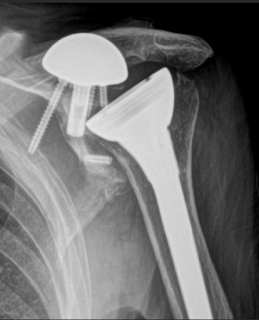A bicortical 44 mm screw was placed in both the superior and posterior glenoid baseplate screw holes. Following implantation, the SNN was dissected and visualized through a posterior shoulder approach. The distance from the tip of the screws to the SSN and the distance from the screw’s scapular exiting hole to the SSN was recorded.
The superior screw contacted the SSN in 8 of the 12 specimens (66%). For the superior screw, the average distance from the exiting point in the scapula to the SSN was 9.2 ± 6.3mm with the shortest distance being 3.9 mm. The posterior screw contacted the SSN in 6 of 12 specimens (50%). For the posterior screw, the average distance from the exiting point to the SSN was 8.9 ± 3.8 mm with the shortest distance to the nerve being 2.2 mm.
Comment: While being the screw most likely to risk the supra scapular nerve and while being the screw most likely to predispose the scapular spine to fracture, the superior baseplate may be the least important screw for baseplate stability as shown below.
Factors affecting fixation of the glenoid component of a reverse total shoulder prothesis
The baseplate of the reverse total shoulder usually fails from superiorly directed loads
The baseplate of the reverse total shoulder usually fails from superiorly directed loads
Using an in vitro model these authors examined some of the factors affecting the quality of glenoid screw fixation, including the density of the material into which the screws are placed, the purchase of individual screws, and the direction of loading in relation to screw placement.
They found that
(1) Load to failure was less when the glenoid component was fixed to material of lesser density.
(2) While each screw contributed to the quality of fixation; the screw nearest the point of load application made the largest contribution.
(3) Load to failure was less when the load was colinear with a line through the nonlocking holes in the base plate compared to colinear with a line through the locking holes.
(4) For the most important direction of loading - a superiorly directed force applied to the glenosphere - the inferior screw appeared to be the most critical.
As shown in the diagram below, superiorly directed loads applied to the glenosphere by the humeral component (black arrow) subject the critical inferior screw to traction (red arrow), while the bone at the superior aspect of the glenoid (represented by the grey box) is subjected to compression (green arrow) - which results in minimal loading of the superior screw.
For these reasons we prefer to shorten the drill hole and the screw used in the superior hole of the baseplate and work to assure good bony support for the superior aspect of the baseplate.
===
To see a YouTube of our technique for a reverse total shoulder arthroplasty, click on this link.
=====
To see our new series of youtube videos on important shoulder surgeries and how they are done, click here.
Use the "Search" box to the right to find other topics of interest to you.
You may be interested in some of our most visited web pages arthritis, total shoulder, ream and run, reverse total shoulder, CTA arthroplasty, and rotator cuff surgery as well as the 'ream and run essentials'




